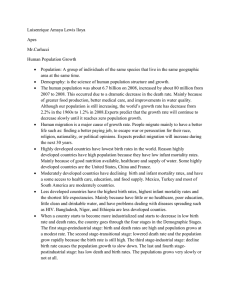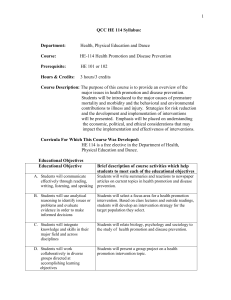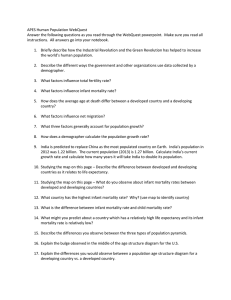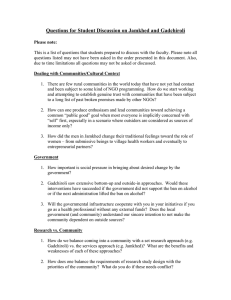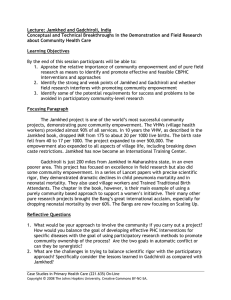This work is licensed under a . Your use
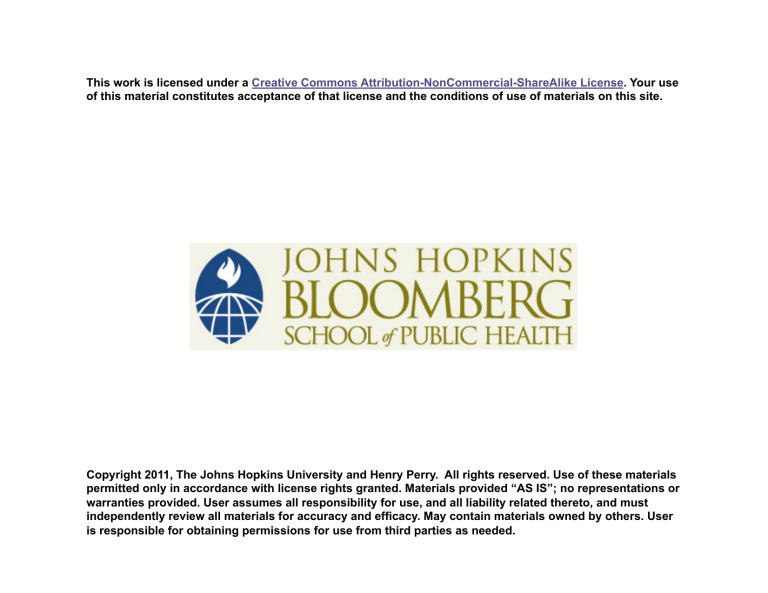
This work is licensed under a Creative Commons Attribution-NonCommercial-ShareAlike License . Your use of this material constitutes acceptance of that license and the conditions of use of materials on this site.
Copyright 2011, The Johns Hopkins University and Henry Perry. All rights reserved. Use of these materials permitted only in accordance with license rights granted. Materials provided “AS IS”; no representations or warranties provided. User assumes all responsibility for use, and all liability related thereto, and must independently review all materials for accuracy and efficacy. May contain materials owned by others. User is responsible for obtaining permissions for use from third parties as needed.
Section B
Evidence for Integrated Approaches
Analysis of Integrated Projects Included in the Review
Review of studies with at least three child survival interventions and at least four years of implementation
40 studies/projects identified
3
Characteristics of 40 Integrated Projects
Population
Number of interventions
Duration
Median
158,000
10
5 years
Range
10,500–10 million
6–15
4–43 years
Study design N
Baseline/final without comparison
Baseline/final with comparison
Types of projects
78%
22%
USAID Child Survival to PVOs: 67%
Long-term community health program: 17%
Research-oriented field project: 11%
Other international donor-funded project: 6%
4
Community Processes in Intervention Implementation
Community process Number
Use some type of community-based outreach agent 100%
Had strong community involvement/ engagement/mobilization 94%
Involved in strengthening health system capacity 100%
5
Types of Community Outreach Workers
CHWs/VHWs
Health agents
Promoters
Family health workers
Peer educators
Family planning agents
Malaria/nutrition agents
Community case management workers
Lead mothers
Community health extension workers
Animators
Community health officers
Mobile clinic team
Care groups
“Socoristas”
“Accompagnateurs”
Health surveillance assistants
Community surveillance volunteers
Auxiliary nurses
Bridge to health teams
Nutrition counselor mothers
6
Common Methods of Outreach
Censuses/mapping/family registration common
Routine home visitation common
Drama/dance/songs/puppet shows used to attract the community for health education events
7
Types of Community Involvement/Participation
At community leadership level
Village health committees
Associations of village health committees
Village development committees
Health action committees
Community leadership committees
Meetings with chiefs/mayors/ elders/imams
Imams as community mobilizers
Community meetings/ assemblies
Community pharmacies
Self-sufficient maternity homes
At household level
Health days (for community clean up)
Model mothers
Competitions among mothers for healthiest babies
Breastfeeding support groups
Husbands and mothers-in-law as targets for messages
Pregnant women’s groups
Mothers’ clubs
Child clubs
8
Types of Support
Types of support given by CPHBC programs to MOH health systems
Training MOH health system staff
Provide support for MOH health system logistics (fuel, repair motorbikes, etc.)
Facilitate referral/counter referral
Promote visits of MOH health staff to model programs
Promote regular meetings between community leaders and MOH health facility staff
Communicate messages from MOH facilities to communities
(e.g., community vaccination dates, etc.)
9
Outcomes of 40 Integrated Projects
Improvements in population coverage of key child survival indicators
Reductions in mortality rate
Median
24%
55%
Range
13–91%
24–89%
10
Reviews of Integrated Approaches
1980: Can Health and Nutrition Interventions Make a Difference?
(monograph)
1993: Effects of Health Programs on Child Mortality in Sub-Saharan
Africa (book)
2006 and 2007: Estimation of Impact of USAID PVO Child Survival
Projects (USAID website)
2007: Impact of Packaged Interventions on Neonatal Health (Health
Policy and Planning)
11
Health and Nutrition Interventions
12
Health Programs
13
Ewbank and Gribble, 1993
“Most of these studies examine the effects of single interventions, and many are closer to carefully controlled clinical trials than they are to evaluations of large-scale programs. Therefore we cannot make strong statements about the overall effectiveness of health programs in Africa … [T]here are very few studies of the effects of health centers and integrated programs on mortality, and no studies that attempt to estimate the effectiveness of hospitals in reducing population levels of mortality.”
14
Update on Bellagio Calculator Approach
Update on Bellagio calculator approach to assessment of USAID PVO child survival projects
32 projects ending since 2005: primary focus CBPHC and child survival
Median population served: 350,000
Median cost $5.55 per beneficiary per year
Source: Jim Ricca, ORS/Macro. (January, 2008). Presentation at USAID. 15
Outcomes for Each Project
Average reduction in U5M: 25%
Average estimated number of lives saved: 883
Average USAID cost per life saved: $1,293
Average USAID cost per DALY saved: $43
Two-thirds of impact through community-level interventions
(especially ORT use, breastfeeding, community-based prescription of pneumonia)
The larger the project and the higher the mortality levels, the lower the cost/DALY saved
16
Packages of Neonatal Health (41 Studies)
Review of packages of interventions which had more than one plausible biological effect
Few studies of any “complete” packages (antenatal, intrapartum and postpartum) which were recommended in the Lancet neonatal series
Interventions appeared to be bundled on basis of convenience or funding requirements
No studies of true effectiveness of packages (in routine conditions) at scale
Source: Haws et al. (2007). Health Policy and Planning. 17
Examples of Sustained Impact of Integrated Programs
How long have these programs improved child health?
18
Mortality Rates in Intervention and Comparison Areas
Matlab Infant and One- to Four-Year Mortality Rates in Intervention and Comparison Areas
Henry Perry
19
The Jamkhed Comprehensive Rural Health Project
20
Jamkhed Comprehensive Rural Health Project, India
Jamkhed Comprehensive Rural Health Project, India (150,000 people)
Major external evaluation of mortality impact compared to surrounding villages currently underway by researchers at the
London School of Economics and at the London School of Hygiene
Source: Arole and Arole. (1994 .
) 21
Infant Mortality Rates
Jamkhed CRHP Infant Mortality Rates Compared to
Estimated Rates for Rural Maharahstra
Note: rates for rural Maharashtra are the infant mortality rates among mothers with less than 5 years of education for the entire state inflated by 10% since rural rates in general are 10% greater than rates for the overall population.
22
Henry Perry
External Mortality Assessment of the Jamkhed CRPH
U5M
NNM
1-59 month MR
Crude
Control 1
Control 2
Crude
Control 1
Control 2
Crude
Control 1
Control 2
Hazard
Ratio
0 · 92
0 · 90
0 · 90
1 · 06
1 · 03
1 · 03
0 · 72
0 · 70
0 · 71
Age period
0 · 77
0 · 75
0 · 75
0 · 84
0 · 82
0 · 82
0 · 54
0 · 52
0 · 52
1 · 11
1 · 08
1 · 09
1 · 33
1 · 29
1 · 30
0 · 96
0 · 94
0 · 95
Source: Bulletin of the World Health Organization (in press). 23
Hospital Albert Schweitzer, Haiti (150,000 people)
24
Hospital Albert Schweitzer, Haiti (150,000 people)
25
Mortality Rates
Gadchiroli/SEARCH Mortality Rates in Intervention and Comparison Area in Rural Maharahstra
Henry Perry
26
Infant and Child Mortality
Infant and Child Mortality in the Navrongo Initiative Area and Ghana Nationally, 1993–2003
Source: Phillips et al. (2006). Bull WHO.
UER: Upper East Region
27
BRAC
28
Successful Programs for Improving Child Health
Source: Hospital Albert Schweitzer (Haiti), Imesi Ile/Wesley Guild (Nigeria), Matlab (Bangladesh), Jamkhed (India), BRAC
(Bangladesh), SEARCH (India), and Navrongo (Ghana). 29
Cost Effective?
How cost-effective is CBPHC in improving child health?
30
CBI to Improve Child Health
Cost per DALY Averted with Community-Based Interventions to Improve Child Health
Henry Perry
First-line ARV treatment: $350–2,010 per DALY averted (Denny and Emanuel, 2008)
31
CBI to Improve Child Health
Cost per DALY Averted with Integrated Community-Based
Interventions to Improve Child Health
Henry Perry
32

